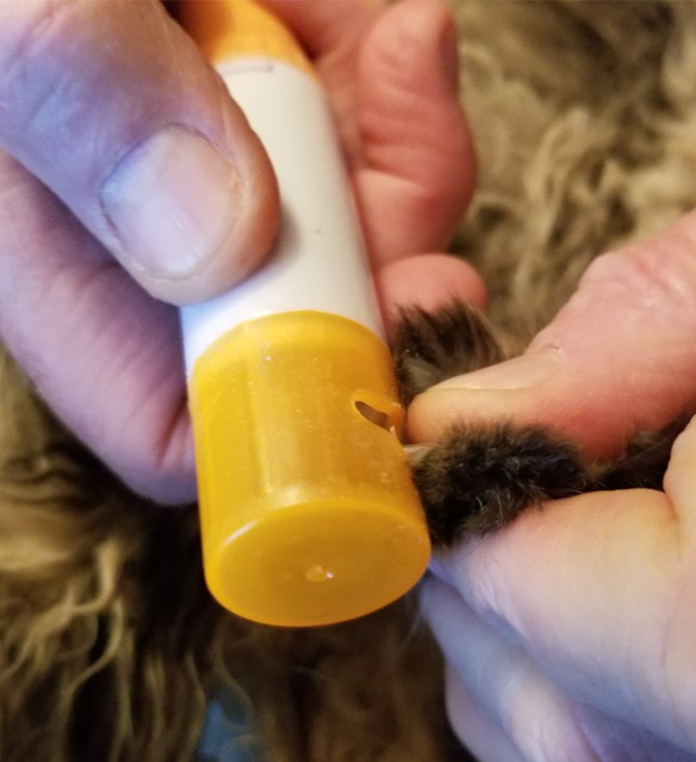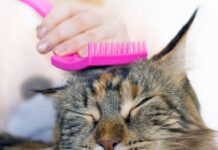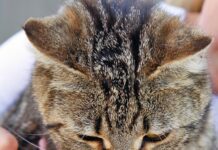Nail care should be a part of your cat’s routine health maintenance. Many cats wear their nails down on their own, but others can be prone to overgrowth (see sidebar). Check your cat’s nails regularly to monitor their length. You may also notice extra-long nails when your cat jumps on or off your lap and accidentally stabs you! Whatever the reason, if your cat’s nails are overgrown, you must trim them back.
Nail trimming is stressful for many cat owners for two reasons: an uncooperative cat and fear of hurting the cat. If your cat is not thrilled about having her paws handled, start by just working on that. Gently touch his paws briefly while he is resting by or playing with you, gradually increasing how much you handle his paws over time. You can also reward him with treats, petting, or play for letting you touch his paws. Work on it a little bit every day so it becomes part of your normal routine.
When to Use a Nail Grinder
If your cat is afraid of the click of nail clippers or you are concerned about hitting the quick in his nails and causing him to bleed, nail grinders can help. Nail grinders are tools that grind down nails with a head that rotates at high speed.
Nail grinders do make noise, but rather than the sharp, sudden click of nail clippers, it is a constant hum, which some cats adjust to quickly.
You can still hit your cat’s quick if you go too far with a nail grinder, but the high speed of the grinder head will often cauterize the blood vessels immediately and prevent bleeding (hitting the quick still hurts, though). Some nail grinder models have caps to limit how much of the nail can be ground off, but the success of these attachments depends on the size of your cat’s toes and how grown out the quick is, so you still need to pay attention as you work to prevent discomfort. Thankfully, most cats have white/clear nails, which makes it easy to see where the pink quick is.
Another benefit to using a nail grinder is that it smooths out the end of your cat’s nails rather than leaving sharp edges that can still scratch your skin when your cat moves across your lap.
Choosing a Nail Grinder
Leni Kaplan, DVM, MS, Lecturer in Cornell’s Community Practice Service, advises, “Pet owners should consider getting a grinder that has at least two speeds; most owners (unless very experienced) will want to use the slower speed to start, depending on the size of the nail and how close they are to the quick.” Speed will also impact the intensity and frequency of the noise the grinder makes, so your cat may prefer one speed over another simply because of the sound it produces. Dr. Kaplan also recommends getting a cordless grinder. “This eliminates the hanging cord, which may scare the pet when it moves as the grinder moves. The pet will also not get inadvertently tangled in the cord during nail grinding with a cordless product,” she says.
You may hear nail grinders referred to as “dremels” because Dremel is a popular and well-known brand of tools that use rotating heads. Most grinders come with a head made of a material like robust sandpaper, but you can also invest in a diamond bit for extra durability.
If possible, “test drive” a grinder before purchasing. This will give you a chance to see how the product feels in your hand and how loud it is on the different speed settings.
Introducing the Grinder
“GO SLOW and be patient,” advises Dr. Kaplan. “Pets tend to be skeptical about this new object that makes a humming noise, gets hot with use, and produces a strange odor.” Unless you have an extremely confident and relaxed cat, you will not be able to grind all of your cat’s nails on the first day.
Use these steps to introduce the tool:
- After purchasing the nail grinder, put it on the floor and give your cat a treat every time he goes near it.
- Once your cat does not seem to care about the object, move it closer to his feet, and if he does not object, give him a treat.
- As he gets more comfortable, desensitize him to the grinder by touching his paws gently with the grinder when it is OFF and give him a treat as he learns to tolerate this.
- When he seems fairly comfortable with the grinder, start to turn it on for a few seconds at a time so he gets used to the humming noise. Remember to give him treats so he associates treats (a positive experience) with the grinder.
- Over time, keep the grinder on for longer periods, always giving positive reinforcement (treats, verbal praise) to your cat.
- When first using the grinder, trim only one or two nails at a time until he gets used to the grinder.
For some cats, this process may take months (especially if you need to get your cat used to having his feet handled first). But it’s worth it! By the end of the process, you will have a relaxed cat who tolerates nail trims rather than fighting you and trying to escape.
What You Should Know
- The humming noise may be scary to your cat.
- The grinders can get hot with use, so make sure to take breaks and don’t spend too much time on any one nail.
- The ground-up nail bits have a pungent odor that some cats don’t like. You can wear a mask to prevent inhalation of nail particles.
- The vibration of the grinder on the nail will feel strange to your cat and may take some time and gradual exposure to get used to.
- Long hair can get caught in the grinder, which hurts. Trim hairy feet or hold the hair back away from the nail with your fingers.
- If you sense your cat is losing patience with you, cut the session short and come back to it later.
Why Do I Need to Trim My Cat’s Nails?
Many cats successfully wear their nails down by using scratching posts (hopefully the ones intended for that use and not co-opted furniture!), but others are either not as active or have been blessed (cursed?) with fast-growing nails. Older cats in particular are prone to thick, overgrown nails. Polydactyl cats (cats with extra toes) are also at risk for overgrown nails, as the nails on extra toes may not come in contact with the ground and the surface of scratching posts.
Nails allowed to grow unchecked can curl under and into your cat’s paw, causing pain and promoting infection. As the nail pierces the paw pad or skin, it creates an open wound on the base of the foot. This wound is an easy entry point for any bacteria or other microbes that your cat may encounter, including when she steps in her litterbox.
If You Hit the Quick
If you hit the quick when grinding your cat’s nails, she will likely jerk her paw away suddenly. Don’t panic! Calmly pick your cat’s paw up again and pet her and praise her for letting you hold it. Then turn the grinder back on and touch it to the outer edge of the same nail briefly before praising and rewarding. Touching the grinder to the outer edge will avoid contacting the sensitive quick in the center again, and gives you the opportunity to reinforce that nail grinding is not a scary event. After telling your cat how wonderful she is, do at least one more nail before quitting for the day.




